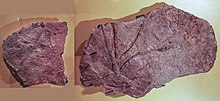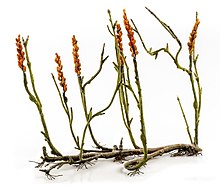
Lycopodiopsida is a class of vascular plants known as lycopods, lycophytes or other terms including the component lyco-. Members of the class are also called clubmosses, firmosses, spikemosses and quillworts. They have dichotomously branching stems bearing simple leaves called microphylls and reproduce by means of spores borne in sporangia on the sides of the stems at the bases of the leaves. Although living species are small, during the Carboniferous, extinct tree-like forms (Lepidodendrales) formed huge forests that dominated the landscape and contributed to coal deposits.

The lycophytes, when broadly circumscribed, are a vascular plant (tracheophyte) subgroup of the kingdom Plantae. They are sometimes placed in a division Lycopodiophyta or Lycophyta or in a subdivision Lycopodiophytina. They are one of the oldest lineages of extant (living) vascular plants; the group contains extinct plants that have been dated from the Silurian. Lycophytes were some of the dominating plant species of the Carboniferous period, and included the tree-like arboresencent lycophytes, some of which grew over 40 metres (130 ft) in height, although extant lycophytes are relatively small plants.

Drepanophycales is an order of extinct lycopsid plants of Late Silurian to Late Devonian age, found in North America, China, Russia, Europe, and Australia. Sometimes known as the Asteroxylales or Baragwanathiales.
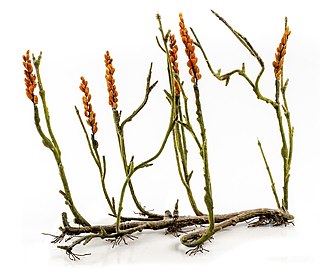
Zosterophyllum was a genus of Silurian-Devonian vascular land plants with naked branching axes on which usually kidney-shaped sporangia were arranged in lateral positions. It is the type genus for the group known as zosterophylls, thought to be part of the lineage from which modern lycophytes evolved. More than 20 species have been described.
Crenaticaulis was an early genus of slender, dichotomously branching, leafless land plants, known from the Devonian period and first described in 1969. They were probably allied to the zosterophylls, and are assigned to subdivision Zosterophyllophytina, or class Zosterophyllopsida. They bore branches and scalariform tracheids.

Pertica is a genus of extinct vascular plants of the Early to Middle Devonian. It has been placed in the "trimerophytes", a strongly paraphyletic group of early members of the lineage leading to modern ferns and seed plants.
Krithodeophyton is a genus of lower Devonian plant with branching axes. It is considered to be a barinophyte.
Psilophytopsida is a now obsolete class containing one order, Psilophytales, which was previously used to classify a number of extinct plants which are now placed elsewhere. The class was established in 1917, under the name Psilophyta, with only three genera for a group of fossil plants from the Upper Silurian and Devonian periods which lack true roots and leaves, but have a vascular system within a branching cylindrical stem. The living Psilotaceae, the whisk-ferns, were sometimes added to the class, which was then usually called Psilopsida. This classification is no longer in use.

Yunia is a genus of extinct vascular plants from the Early Devonian. It was first described from the Posongchong Formation of Yunnan, China. The leafless plant consisted of spiny stems, some 2 to 5 cm wide, which branched dichotomously at wide angles in a cruciate arrangement. Each stem contained vascular tissue with one or two strands of protoxylem. The spore-forming organs (sporangia) were elongated and borne on short stalks. The spores had a relatively smooth sculptural pattern and were trilete.
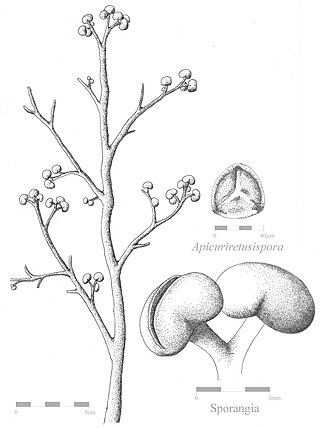
Renalia is a genus of extinct vascular plants from the Early Devonian. It was first described in 1976 from compressed fossils in the Battery Point Formation. It is difficult to reconstruct the original form of the complete plant, but it appears to have consisted of leafless branching stems whose side branches had sporangia at their tips. It is regarded as an early relative of the lycophytes.
Huia is a genus of extinct vascular plants of the Early Devonian. The genus was first described in 1985 based on fossil specimens from the Posongchong Formation, Wenshan district, Yunnan, China.

Adoketophyton is a genus of extinct vascular plants of the Early Devonian. The plant was first described in 1977 based on fossil specimens from the Posongchong Formation, Wenshan district, Yunnan, China. These were originally named Zosterophyllum subverticillatum; later the species was transferred to a new genus as Adoketophyton subverticillatum. One cladistic analysis suggested that it is a lycophyte, related to the zosterophylls. Other researchers regard its placement within the vascular plants as uncertain.
Discalis is a genus of extinct vascular plants of the Early Devonian. The name is derived from the Greek δίσκος, referring to the disc-shaped sporangia. The genus was first described by Hao in 1989 based on fossil specimens from the Posongchong Formation, Wenshan district, Yunnan, China.
Distichophytum is a genus of extinct vascular plants of the Late Silurian (Ludfordian) to Early Devonian (Emsian), around 426 to 393 million years ago. The genus has a tangled taxonomic history, also being known as Bucheria and Rebuchia.
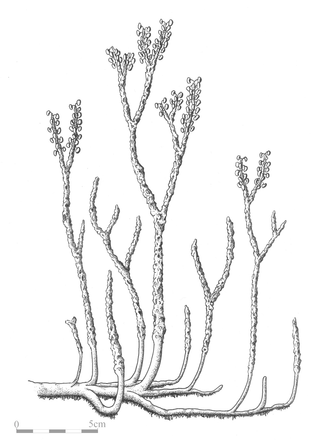
Nothia was a genus of Early Devonian vascular plants whose fossils were found in the Rhynie chert in Scotland. It had branching horizontal underground stems (rhizomes) and leafless aerial stems (axes) bearing lateral and terminal spore-forming organs (sporangia). Its aerial stems were covered with small 'bumps' (emergences), each bearing a stoma. It is one of the best described early land plants. Its classification remains uncertain, although it has been treated as a zosterophyll. There is one species, Nothia aphylla.
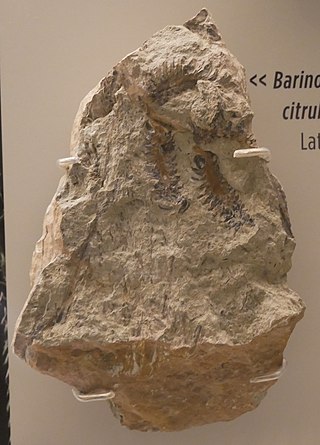
Barinophyton was a genus of early land plant with branching axes. It is placed in a group of early vascular plants (tracheophytes), the barinophytes, a group that has been given various ranks and scientific names. Known fossils are of Devonian to Carboniferous age.
Protobarinophyton was a genus of Silu-Devonian land plant with branching axes. It is placed in a group of early vascular plants (tracheophytes), the barinophytes, a group that has been given various ranks and scientific names.
Wenshania is a genus of extinct vascular plants found in the Posongchong Formation, Yunnan, China, which is of Early Devonian age. Plants consisted of leafless stems with simple dichotomous branching, and bore spore-forming organs or sporangia all around the sides of stems. Wenshania is part of the broadly defined group of zosterophylls.
Gosslingiales is an order of extinct zosterophylls. The zosterophylls were among the first vascular plants in the fossil record, and share an ancestor with the living lycophytes. The group has been divided up in various ways. Hao and Xue in 2013 used the presence or absence of terminal sporangia as a major dividing feature. The order Zosterophyllales was used for species with terminal as well as lateral sporangia, which were considered to have determinate growth, with their sporangia generally being arranged in spikes. The paraphyletic order Gosslingiales was used for species without terminal sporangia, which were considered to have indeterminate growth, with fertile branches generally circinate. Species assignable to the Gosslingiales made up about 9% of all confirmed species in the Early Devonian flora.
The barinophytes are a group of extinct vascular plants (tracheophytes). Their relationship with other vascular plants is unclear. They have been treated as the separate class Barinophytopsida, the order Barinophytales of uncertain class and as a family or clade Barinophytaceae within the zosterophylls. They have also been considered to be possible lycopodiopsids.
